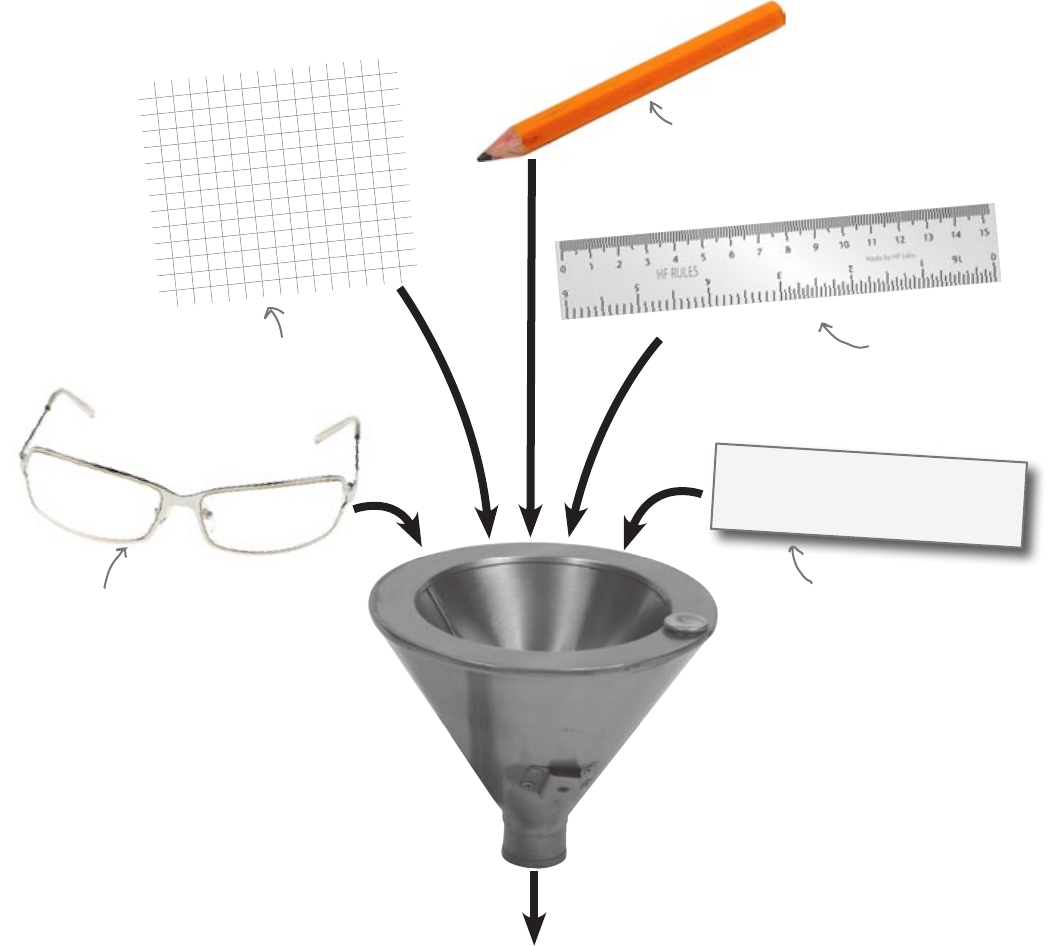
testing with accurate construction
You can use accurate construction to
test ramp designs on paper
Accurate construction is different from making a sketch.
A s
har
p p
encil
A c
entimeter ruler,
ideall
y one wi
th
millimeter markings
as w
ell
A sca
le
You’ll need:
Scale: 1cm
=
1 Kwik-klik unit
Y
our eyes
Gr
id pap
er in
incr
ements of
c
entimeter
s
ACCURATE CONSTRUCTION
108 Chapter 3

the pythagorean theorem
Hello? Didn’t you spend
chapters 1 & 2 going on
about how we couldn’t trust
a drawing, couldn’t just
measure it, blah, blah, blah?
True. But making an accurate
construction is different.
How is making your own accurate drawing different from just
measuring a sketch or diagram you’re given? Write out your
answer in words below.
you are here 4 109

your drawing is accurate
110 Chapter 3
How is making your own accurate drawing different from just
measuring a sketch or diagram you’re given?
Right, so if we
know we’ve kept to the same
scale—like using a line exactly
3cm long for a size 3 Kwik-klik
piece—we can use drawing to kind
of simulate the ramp?
Yup. If you can’t draw it with a right
angle, then you can’t build it with a
right angle, either!
Centimeter grid paper has horizontal and vertical
lines which are perfectly perpendicular—making
it extra useful for drawing shapes with right angles
like our ramps need to be. Just try it out.…
If you’re drawing the diagram yourself you can keep it in proportion, and you can get the
angles right, too. You can use a set square or a protractor, or gridded paper, to make
sure lines that are supposed to be perpendicular are drawn at right angles.
If you draw a line 3cm and another line 6cm—measured with a good ruler—you know for
sure that the first line you drew is half the length of the other.
When you’re given a sketch you don’t know whether the person who drew it used a ruler
and protractor to make the drawing accurate, or just did it roughly.
Y
our answ
er might be w
orded
dif
ferentl
y—tha
t’s OK, it’s
the thought tha
t counts....

the pythagorean theorem
T
he lines on this pap
er ar
e
p
er
p
endicul
ar, so w
e know
tha
t this is a right angle.
T
his line represents the base
of y
our ramp—so the length
is exac
tl
y 12 cm.
As close as y
ou can measur
e
wi
th a millimeter ruler,
don’t w
orry about getting a
magnifi
er out!
If one of these dashed lines is exactly
13cm long, then it’ll meet the vertical
line at the height you need to use.
Use accurate construction to find what length the vertical piece
needs to be in order for the ramp to have a perpendicular upright.
Using a scale of 1cm to 1 Kwik-klik unit (so a piece of length 2
would be drawn as 2cm), use your ruler to find the part that fits.
and ruler
you are here 4 111

sharpen solution
Use accurate construction to find what length the vertical pole
needs to be in order for the ramp to have a perpendicular upright.
Using a scale of 1cm to 1 Kwik-klik unit (so a part of length 2
would be drawn as 2cm), use your ruler to find the part that fits.
and ruler solution
5cm
T
his line is exac
tl
y 13cm long.
The size 5 upright gives us a perfect vertical
The parts with lengths 12, 13, and 5 make a perfect ramp with
a right angle between the horizontal and vertical parts.
Of course what we just drew was a scaled version of our final
ramp—nobody wants a skate ramp 5cm high, but a ramp that’s
5 kwik-klik units high is plenty big enough.
If one of these dashed lines is exactly
13cm long, then it’ll meet the vertical
line at the height you need to use.
112 Chapter 3
Get Head First 2D Geometry now with the O’Reilly learning platform.
O’Reilly members experience books, live events, courses curated by job role, and more from O’Reilly and nearly 200 top publishers.

